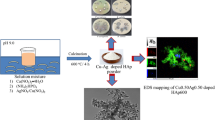Abstract
Nanoparticles of hydroxyapatite(HAP), strontium half substituted hydroxyapatite (SrCaHAP) and strontium totally substituted hydroxyapatite (SrHAP) were prepared by sol-gel-supercritical fluid drying (SCFD) method. The nanoparticles were characterized by element content analysis, FT-IR, XRD and TEM, and the effects of strontium substitution on crystal structure, crystallinity, particle shape and antibacterial properties of the nanoparticles on Escherichia coli, Staphylococcus aureus, Lactobacillus were researched. Results show that strontium can half and totally substitute for calcium and enter the structure of apatite according to the initial atomic ratios of Sr/[Sr+Ca] as 0.5, 1. The substitution decreases the IR wavenumbers of SrCaHAP and SrHAP, and changes the morphology of the nanoparticles from short rod shaped HAP to needle shaped SrCaHAP, and back to short rod shaped SrHAP. The crystallinity of HAP is higher than that of SrCaHAP, but is lower than that of SrHAP. Moreover, the antibacterial property of SrCaHAP and SrHAP are improved after the calcium is half and totally substituted by strontium.
Similar content being viewed by others
References
Y F WANG, Y H YAN, M J LI, et al. Influential Factors on Morphology of Hydroxyapatite Crystals[J]. Journal of Wuhan University of Technolog-Mater. Sci. Ed, 2003, 18(1):33–36
Hideki, Aoki. Science and Medical Applications of Hydroxyapatite[J]. Japanese Association of Apatite Science, 1992:137–190
Y J SONG, M S LI, Y P LV, et al. Analysis on the Difference between Synthetic Hydroxyapatite and Bone Apatite[J]. Journal of Wuhan University of Technology-Mater. Sci. Ed, 2005, 20(Suppl.):170–172
Y F FU, D M CHEN. Infl uence of Sr2+ on Strontium Substituted Hydroxyapatite’s (Sr-HA)[J]. J Oral Tissue Eng, 2005, 2(2):76–80
A Bigi, E Foresti, M Gandolfi, et al. Inhibiting Effect of Zinc on Hydroxylapatite Crystallization[J]. Journal of Inorganic Biochemistry, 1995, 58:49–58
T N KIM, Q L FENG, J O KIM, et al. Antimicrobial Effects of Metals Ions in Hydroxyapatite[J]. Journal of Materials Science: Materials in Medicine, 1998, 9:129–134
F Q DONG, G W LI, Z G SUN, et al. Preparation and Antimicrobial Ability of Natural Porous Antibacterial Materials[J]. J. Cent. South. Univ. Technol, 2005, 12(4):370–375
D Gerlalia. Effects of Strontium and Fluoride Uptakes on the Solubility of Powdered Enamel[J]. Caries Res. 1997, 11(2): 287–292
K ZHAO, Q L FENG, G Q CHEN. Antibacterial Effects of Silver Loaded Hydroxyapatite[J]. Tsing Hua Science and Technology, 1999, 4(3):1570–1573
J Christoffersen, M R Christoffersen, N Kolthoff, et al. Effects of Strontium Ions on Growth and Dissolution of Hydroxyapatite and Bone Mineral Detection[J]. Bone, 1997, 20(1): 47–54
D P LIAO, Z Y ZHOU, Y F GU. A Fundamental Study on Bioreactions of SrHA[J]. West China Journal of Stomatology, 2002, 20(3):172–174 (in Chinese)
D G GUO, K W XU, X Y ZHAO, et al. Development of a Strontium-containing Hydroxyapatite Bone Cement[J]. Biomaterials, 2005, 26:4073–4083
Y M ZHANG, Q T WANG, T FU. Wet Synthesis and Structure Stability of Strontium-containing Hydroxyapatite[J]. Rare Metal Materials and Engineering, 2004, 33(10):1049–1051 (in Chinese)
H W KIM, Y H KOH, Y M KONG, et al. Strontium Substituted Calcium Phosphate Biphasic Ceramics Obtained by a Powder Precipitation Method[J]. Journal of Materials Science: Materials in Medicine, 2004, 15: 1129–1134
Z Y LI, X D ZHANG, D P HU. Tunable Fluids and Green Chemical Processes. Chemistry, 2003, 66(5): 323–326 (in Chinese)
Z Y LI, Y LI, X W DING. Application of Supercritical Fluids in Micro-powder Formation[J]. Journal of Chemical Industry & Engineering, 2000, 21(4): 6–12 (in Chinese)
Author information
Authors and Affiliations
Corresponding author
Rights and permissions
About this article
Cite this article
Lin, Y., Yang, Z., Cheng, J. et al. Synthesis, characterization and antibacterial property of strontium half and totally substituted hydroxyapatite nanoparticles. J. Wuhan Univ. Technol.-Mat. Sci. Edit. 23, 475–479 (2008). https://doi.org/10.1007/s11595-006-4475-2
Received:
Accepted:
Published:
Issue Date:
DOI: https://doi.org/10.1007/s11595-006-4475-2




